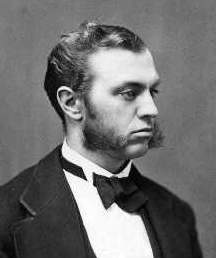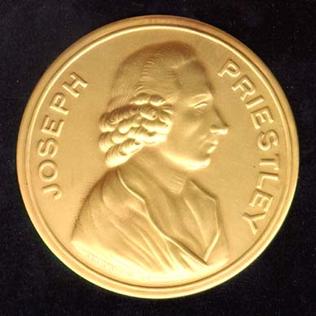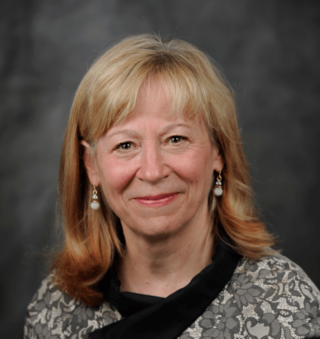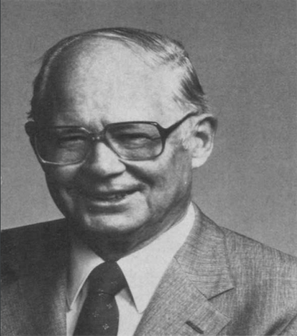
Ira Remsen was an American chemist who discovered the artificial sweetener saccharin along with Constantin Fahlberg. He was the second president of Johns Hopkins University.

The American Chemical Society (ACS) is a scientific society based in the United States that supports scientific inquiry in the field of chemistry. Founded in 1876 at New York University, the ACS currently has more than 155,000 members at all degree levels and in all fields of chemistry, chemical engineering, and related fields. It is one of the world's largest scientific societies by membership. The ACS is a 501(c)(3) non-profit organization and holds a congressional charter under Title 36 of the United States Code. Its headquarters are located in Washington, D.C., and it has a large concentration of staff in Columbus, Ohio.

The Priestley Medal is the highest honor conferred by the American Chemical Society (ACS) and is awarded for distinguished service in the field of chemistry. Established in 1922, the award is named after Joseph Priestley, one of the discoverers of oxygen, who immigrated to the United States of America in 1794. The ACS formed in 1876, spearheaded by a group of chemists who had met two years previously in Priestley's home.

Roger Adams was an American organic chemist who developed the eponymous Adams' catalyst, and helped determine the composition of natural substances such as complex vegetable oils and plant alkaloids. He isolated and identified CBD in 1940. As head of the Chemistry department at the University of Illinois from 1926 to 1954, he influenced graduate education in America, taught over 250 Ph.D. students and postgraduate students, and served in military science during World War I and World War II.

Richard Neil Zare is the Marguerite Blake Wilbur Professor in Natural Science and a Professor of Chemistry at Stanford University. Throughout his career, Zare has made a considerable impact in physical chemistry and analytical chemistry, particularly through the development of laser-induced fluorescence (LIF) and the study of chemical reactions at the molecular and nanoscale level. LIF is an extremely sensitive technique with applications ranging from analytical chemistry and molecular biology to astrophysics. One of its applications was the sequencing of the human genome.
Izaak Maurits (Piet) Kolthoff was an analytical chemist and chemistry educator. He is widely considered the father of analytical chemistry for his large volume of published research in diverse fields of analysis, his work to modernize and promote the field, and for advising a large number of students who went on to influential careers of their own.

Mary Lowe Good was an American inorganic chemist who worked academically, in industrial research and in government. Good contributed to the understanding of catalysts such as ruthenium which activate or speed up chemical reactions.
Paul S. Anderson is an American chemist. He worked at Merck, DuPont-Merck, and Bristol-Myers Squibb.

William Gould Young was an American physical organic chemist and professor at the University of California at Los Angeles (UCLA). He served as vice chancellor at UCLA for 13 years, was elected to the National Academy of Sciences. The chemistry building at UCLA bears his name.

Peter John Stang is an American chemist and Distinguished Professor of chemistry at the University of Utah. He was the editor-in-chief of the Journal of the American Chemical Society from 2002 to 2020.
Donald Frederick Hornig was an American chemist, explosives expert, teacher and presidential science advisor. He served as president of Brown University from 1970 to 1976.
William Albert Noyes Jr., commonly known as W. Albert Noyes Jr., was an American chemist known for his contributions to photochemistry. During World War II, he was a leader in U.S. defense research efforts. He chaired the chemistry department at the University of Rochester, edited several important chemistry journals, and throughout his career was a prominent voice for international scientific cooperation. He was the son of the renowned chemist William A. Noyes; they became the first father-son pair to win the Priestley Medal, the highest honor given by the American Chemical Society.
Franklin Asbury Long was an American chemist notable for his activities in arms reduction as well as for his research in reaction mechanisms of organic molecules in solutions.

Jack H. Freed is an American chemist known for his pioneering work in electron paramagnetic resonance spectroscopy. He is the Frank and Robert Laughlin Professor of Physical Chemistry, emeritus, at Cornell University in Ithaca, New York.

Geraldine Lee Richmond is an American chemist and physical chemist who is serving as the Under Secretary of Energy for Science in the US Department of Energy. Richmond was confirmed to her DOE role by the United States Senate on November 5, 2021. Richmond is the Presidential Chair in Science and professor of chemistry at the University of Oregon (UO). She conducts fundamental research to understand the chemistry and physics of complex surfaces and interfaces. These understandings are most relevant to energy production, atmospheric chemistry and remediation of the environment. Throughout her career she has worked to increase the number and success of women scientists in the U.S. and in many developing countries in Africa, Asia and South America. Richmond has served as president of the American Association for the Advancement of Science, and she received the 2013 National Medal of Science.

Nancy Beth Jackson was an American chemist. She did energy research on heterogeneous catalysis and the development of alternative fuels. She also worked in the field of chemical nonproliferation, educating chemical professionals on the importance of safe and secure chemical practice in research, teaching and business, in an effort to prevent the misuse of chemicals as "weapons, poisons, explosives or environmental pollutants". She was the first implementer in developing the international Chemical Security Engagement Program. She was active in promoting diversity in STEM fields. She was president of the American Chemical Society in 2011, leading the organization during the International Year of Chemistry. In 2012, she was honored with the AAAS Award for Science Diplomacy.

Charles C. Price was an American chemist and president of the American Chemical Society (1965). He taught at the University of Illinois at Chicago, the University of Notre Dame, and the University of Pennsylvania.
The Charles Lathrop Parsons Award is usually a biennial award that recognizes outstanding public service by a member of the American Chemical Society (ACS). Recipients are chosen by the American Chemical Society Board of Directors, from a list of no more than five recipients presented by the ACS Committee on Grants and Awards. They have the discretion to offer the award in successive years if they so wish. It was established in 1952, and is named in honor of its first recipient, Charles Lathrop Parsons. The first woman to receive the award was Mary L. Good in 1991.
Nina Matheny Roscher (1938—2001) was an American chemist and advocate for women and minorities in science. She also researched the history of women in chemistry, publishing the book Women Chemists (1995). She served as professor and chair of the chemistry department at American University in Washington, D.C. She received the ACS Award for Encouraging Women into Careers in the Chemical Sciences (1996) and the Presidential Award for Excellence in Science, Mathematics and Engineering Mentoring (1998).

Warren Dexter Niederhauser was an American chemist who was the President of the American Chemical Society (ACS). He worked at of Rohm and Haas chemical company from 1943 to 1985.













